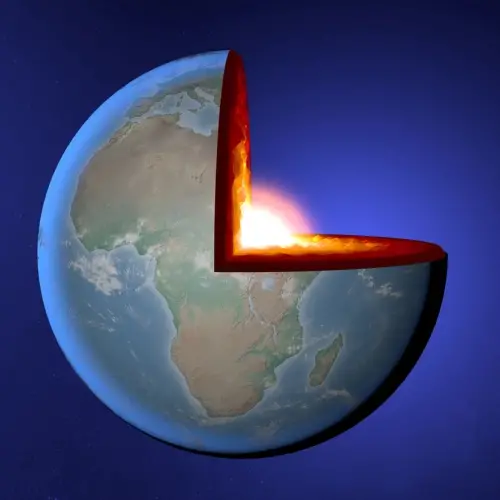
The Earth's heat comes from a combination of physical and chemical processes that occur in different parts of the planet's interior. The Earth is a hot body immersed in a cold space, and it loses temperature constantly, at a rate of approximately 130 ºC every 1,000 million years. This gradual loss is a reflection of the planet's internal dynamics and its geological history.
Volcanoes and hydrothermal systems, like hot springs, are visible manifestations of the Earth's internal heat. These surface evidences allow us to study and better understand the processes that generate and distribute the Earth's heat.
6 Processes that generate the Earth's heat
 The main processes responsible for the Earth's heat are described below, grouped according to the region of the planet's interior where they occur:
The main processes responsible for the Earth's heat are described below, grouped according to the region of the planet's interior where they occur:
- Latent heat of crystallization: At the boundary between the inner core (solid) and the outer core (liquid), crystallization reactions occur that are exothermic and generate heat. This phenomenon, known as latent heat of crystallization, also contributes to maintaining the Earth's magnetic field.
- Gravitation: The gravitational force compresses the inner layers of the planet towards its center, generating heat through friction in the process of contraction of the Earth's mass.
- Remnant heat from planet formation: This heat is a remnant of the collisions between stellar debris in the protoplanetary disk that gave rise to Earth about 4.5 billion years ago. Although it has diminished over time, it still contributes to internal heat.
- Kinetic or friction heat: Energy is generated between the outer core and the mantle in the form of heat due to the friction caused by the different responses of these layers to the gravitational field of the Moon and the Sun (tidal forces).
- Exothermic physicochemical reactions: In the mantle, high pressures and temperatures make minerals unstable, leading to continuous phase changes. These processes release energy in the form of heat.
- Radiogenic decay of isotopes: In the lithosphere (composed of the crust and the upper part of the mantle), rocks contain radioactive elements such as the isotopes 235U, 238U, 232Th and 40K. The decay of these isotopes is exothermic and constitutes the major source of heat on the Earth's surface.
It is important to note that the Earth's temperature increases towards the interior, from a global average of 15 ºC on the surface to more than 5,000 ºC in the inner core.
Geothermal deposits
Geothermal deposits are areas where the Earth's internal heat can be harnessed. There are three main types:
Hot water deposits
These may occur in hot springs or be found in underground aquifers. Hot springs have been used since ancient times as therapeutic baths. In the case of underground deposits, hot water or steam is extracted to generate mechanical energy using turbines or for other uses such as heating.
Dry deposits
In these deposits, the hot layers below the surface do not contain water. Water is injected through boreholes and recovered hot to harness its energy through heat exchangers. The water can then be reinjected to continue the cycle.
Geysers
 Geysers are special hot springs that periodically eject columns of hot water and steam into the air.
Geysers are special hot springs that periodically eject columns of hot water and steam into the air.
Their formation requires specific hydrogeological conditions, making them a rare phenomenon. There are currently about 1,000 geysers on the planet.
When did geothermal energy begin to be used?
At the end of the 17th century, the Earth was conceived as a molten mass with a solid crust resulting from its cooling. During the 19th century, the first calculations of the age of the Earth were made based on its thermal evolution. It was also in this century that geothermal energy was defined as the discipline that studies the Earth's heat, its origin, distribution and use.
The first practical use of geothermal energy took place in 1904 in Larderello, Italy, where electricity was generated by harnessing geothermal steam. Since then, this energy source has been developed as a sustainable option for generating electricity, heating and other industrial uses.